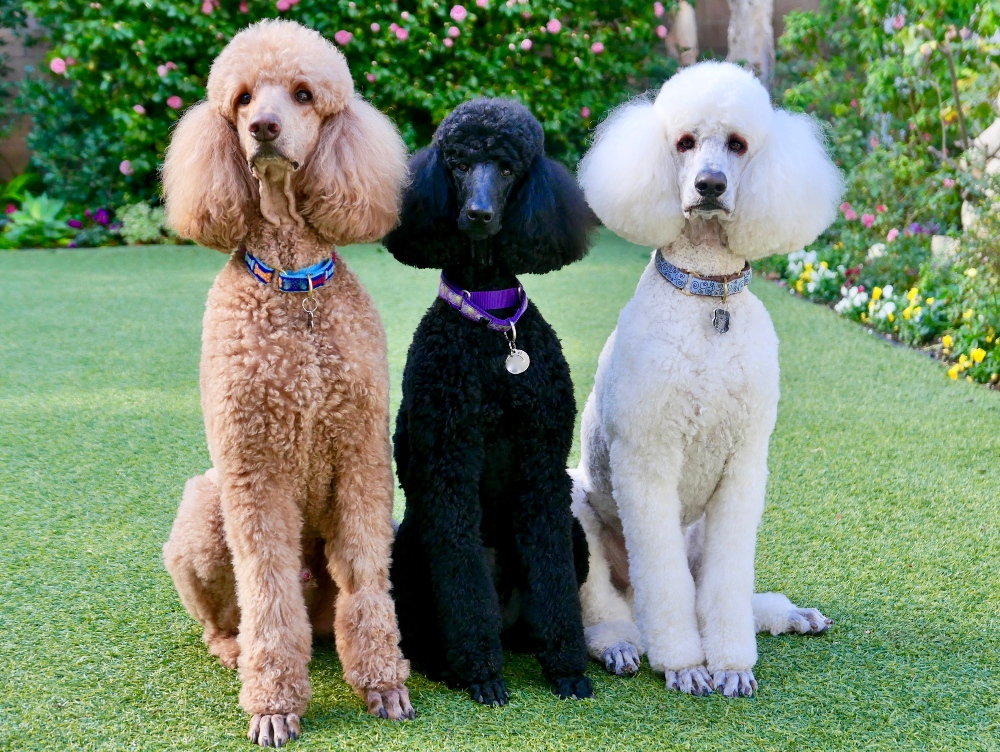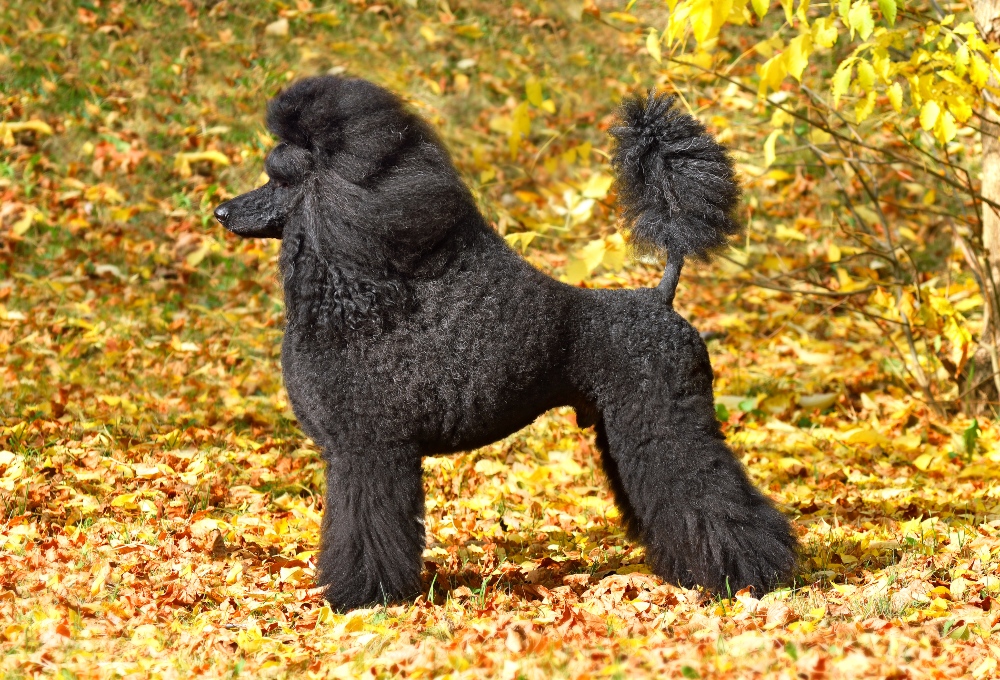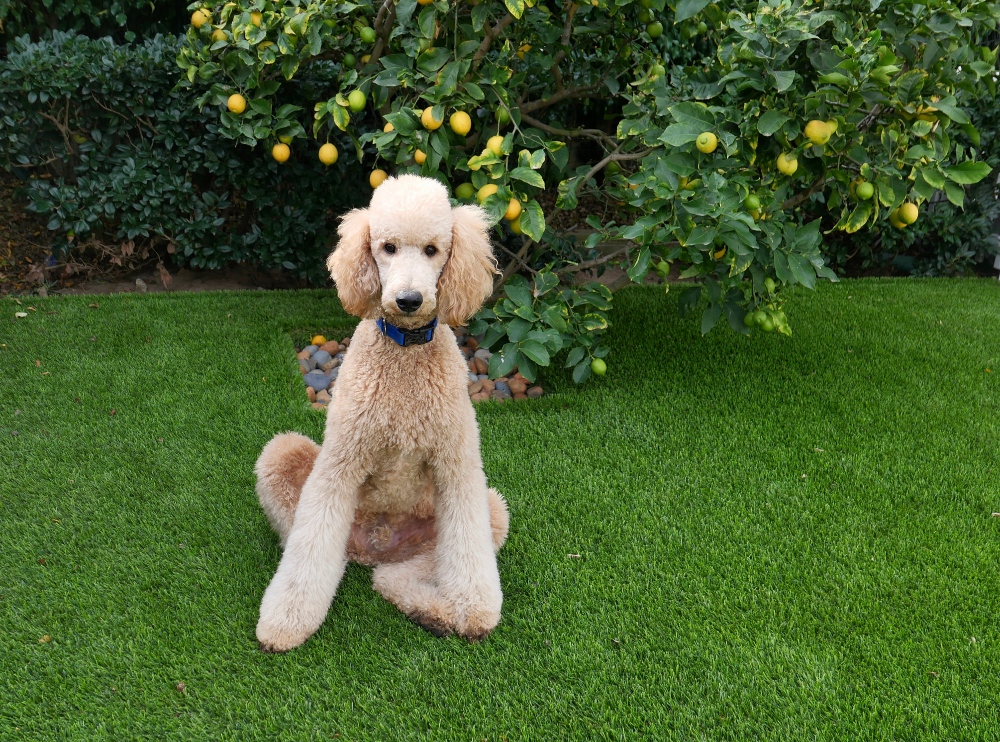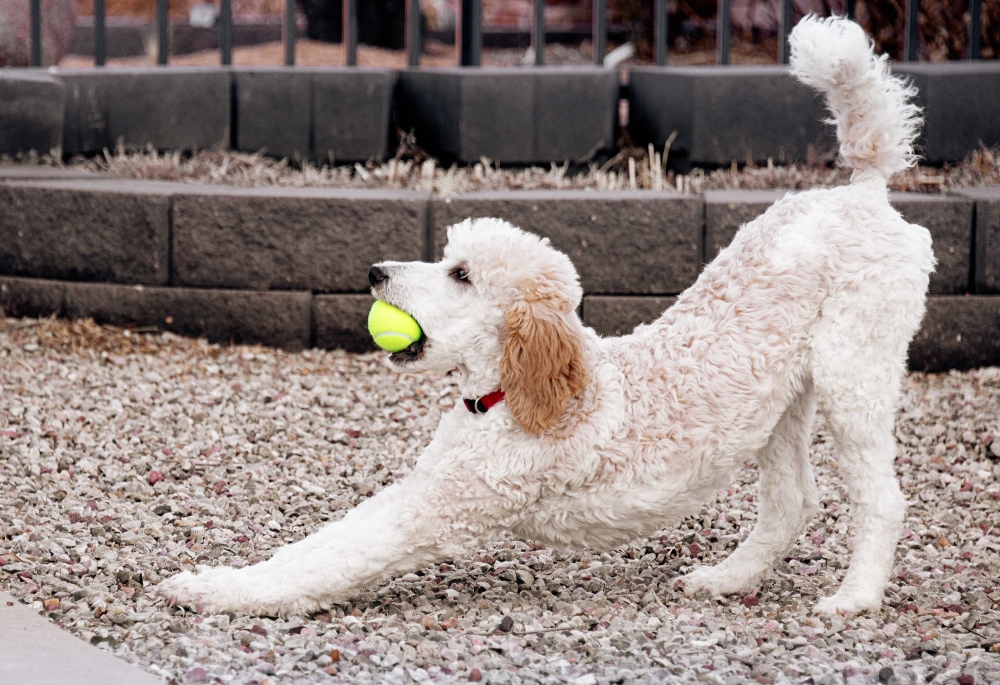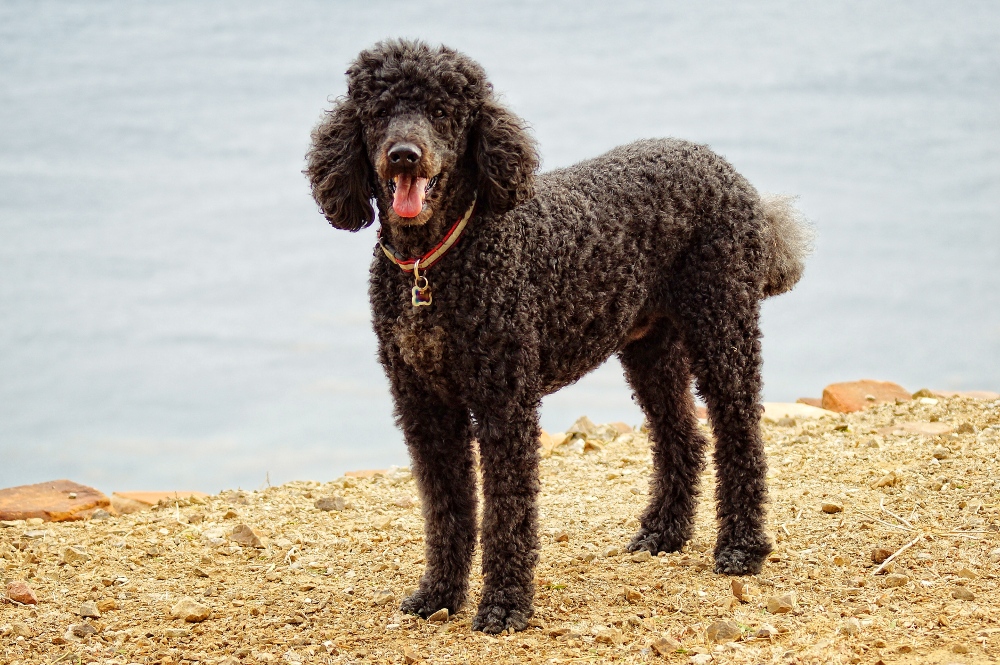Table of Contents
Introduction to Standard Poodles
Standard poodles are smart, proud, active, and beautiful dogs that are very elegant and impressive athletes. There is a misconception that these are prissy dogs, but they are actually very strong, versatile, and great all-around family dogs. They are called “standard” poodles because there are also miniature and toy poodles that have the same breed characteristics but just a smaller size.
Poodles at dog shows often feature the elaborate continental clip, but pet owners often go for the sporting or puppy clip because it is simpler and easier to maintain. These non-sporting group dogs are easy to train and have lots of energy. And while they are low-shedding dogs, they do require a lot of grooming.
Here’s what you need to know about standard poodles before purchasing or adopting one to join your household!
Size of Standard Poodles
Standard poodles are the largest size of poodle that exists and reach an adult weight of 60 to 70 pounds for males and 40 to 50 pounds for females. These dogs stand over 15 inches tall for both genders. In contrast, miniature poodles are 10 to 15 inches tall, and toy poodles are under 10 inches tall.
Here’s how big you can expect your standard poodle to get when fully grown. In these charts, male poodles fall at the high end of the range, while female measurements are at the low end.
| Weight Chart | 2 to 4 months | 4 to 8 months | 8 months to 1 year | 2 years (fully grown |
| Female and Male Standard Poodles | 10 to 22 lbs. | 23 to 45 lbs. | 34 to 65 lbs. | 40 to 70 lbs. |
| Height Chart | 2 to 4 months | 4 to 8 months | 8 months to 1 year | 2 years (fully grown |
| Female and Male Standard Poodles | 13 to 19 in. | 19 to 23 in | 23 to 27 in. | 24 to 27 in. |
Characteristics of Standard Poodles
Standard poodles are adaptable dogs that are great for even first-time pet parents. They are very friendly and not prone to shedding. These very intelligent dogs are easy to train but need a good amount of exercise and attention to stay physically and mentally well. Also, you can expect a standard poodle to be very playful and excel at agility and obedience tests.
As you get to know a standard poodle’s personality, here’s what you can expect based on his or her breed characteristics.
| Breed Characteristic | Level (High, Medium, Low) |
| Affectionate with People | High |
| Good with Kids | High |
| Good with Pets | Medium |
| Need for Exercise | High |
| Energy Level | High |
| Intelligence Level | High |
| Able to Be Trained | High |
| Amount of Barking | Medium |
| Amount of Shedding | Low |
History of Standard Poodles
The history of the standard poodle is closely tied with the country of France, where these dogs are known as the Caniche or “duck dog.” Even though it is the national dog of France, the breed actually originated in Germany as a duck hunting dog. They were bred to be retrieving water dogs hundreds of years ago because of their excellent swimming abilities, high intelligence, retrieving skills, and protective coat. To assist their swimming in water while also being resilient enough to withstand the cold, poodles’ legs, necks, and tails were shaved but the leg joints, hips, and chest were left covered in fur.
These dogs were bred for practical purposes but were quickly appreciated for their elegance and style too. Standard poodles have become a symbol for luxury and sophistication, even becoming a favorite breed among royalty and celebrities.
Standard poodles were later bred down in size to create miniature poodles, and toy poodles were subsequently bred in the early 20th century in America. Yet standard poodles have been recognized as a breed by the American Kennel Club since 1887. Over the years, standard poodles have been used a military dogs, guard dogs, guide dogs, and even circus performers. For many years between the 1960s and 1980s, poodles were the most popular breed of dogs in America.
Standard Poodle Standard Information
To judge these beautiful dogs against one another in a show, there is an official standard established that outlines an ideal appearance, proportions, gait, and temperament.
Here is an overview of the breed standard information for standard poodles:
Head:
- Very dark, oval eyes with alert expression
- Ears hanging close to head
- Skull moderately rounded
- Long, straight, and fine muzzle
- White and strong teeth in scissors bite
Neck, Topline, Body:
- Well-proportioned and strong neck
- Topline neither sloping nor roached
- Chest deep and moderately wide
- Short, broad, and muscular loin
- Tail straight and set on high
Forequarters:
- Smooth, strong, and muscled shoulders
- Strong pasterns
- Dewclaws may be removed
- Small, oval-shaped feet
Hindquarters:
- Straight and parallel hindlegs
- Stifles well-bent
- Rear toes only slightly behind point of rump when standing
Coat:
- Curly, naturally harsh and dense texture
- Corded, hanging in tight and even cords
- Puppy clip for poodles under 12 months
- English saddle clip, continental clip, and sporting clip permissible for adults
- Topknot may be left free or held back with an elastic band
Color:
- Even and solid color
- Blues, grays, silvers, browns, café-au-laits, apricots, and creams
- Natural shading variation is not a fault
Gait:
- Straightforward trot with light springy action
- Strong hindquarters drive
- Head and tail carried up
Caring for Standard Poodles
Standard poodles are adaptable dogs that do well in many different kinds of homes. However, they will need steady human companionship and plenty of exercise to thrive. Because of these dogs’ high intelligence, they can pick up both good habits and bad habits very easily.
Here are some general tips for taking the best care of a standard poodle:
Best Living Environments:
- Apartments okay if sufficiently exercised
- Houses with fenced yards
- Households with children and other pets
Type of Exercise:
- Daily walks
- Swimming in water
- Run and play in off-leash dog parks
- Going for jogs with humans
- Dog sports like agility training and competition
Mental Enrichment:
- Playing fetch in a fenced area
- Snuggle time with favorite humans
- Outdoor time on hikes and in safe water
- Teach how to do tricks
- Puzzle toys
Training Strategies:
- Easy to train and teach obedience
- Try reward-based training with praise and treats
- Make fun games out of training sessions
- Never use punishment or negative training techniques
Grooming Tips:
- Low-shedding, which may help with allergies
- Brushing needed at least every other day to prevent matting
- Have the coat professionally clipped every six weeks
- Choose a sporting or puppy clip for easier maintenance
- Pluck or clip out hair inside of ears
- Brush teeth daily
- Trim nails as needed
Common Health Problems of Standard Poodles
Standard poodles are generally a healthy breed of dog with a long lifespan of up to 18 years. The average lifespan is about 12 to 15 years. However, they are prone to certain genetic diseases, including hip dysplasia, ear infections, and progressive retinal atrophy.
In addition to these issues, here are some additional health issues that commonly arise with standard poodles:
- Cataracts
- Allergies
- Von Willebrand’s disease
- Premature graying (brown poodles)
- Addison’s disease
- Gastric dilatation-volvulus (Bloat)
- Cushing’s disease
- Epilepsy
- Sebaceous adenitis
Diet and Nutrition for Standard Poodles
Standard poodles are at elevated risk for gastric dilatation-volvulus, which is why it is important to feed your dog two to three meals per day rather than just one large meal daily. Also, don’t feed your standard poodle right before it goes out to exercise or play to help prevent bloat.
Most adult dogs will thrive when eating a high-quality, nutritionally complete and balanced dog food. Standard poodle puppies should eat a large breed puppy food until they are around 18 months old. If you feed your standard poodle homemade dog food, make sure you are working from a recipe that is designed by a veterinary nutritionist and is appropriate for your dog’s age and health status.
Feed the amount of dog food needed to keep your pet slim. You should be able to see your dog’s waist and feel (but not see) their ribs without having to press too hard. In general, puppies need more calories per day than adults, but a dog’s needs will vary with his or her activity level and other factors. Don’t leave food out all day for a standard poodle to graze on. Divide the total amount of food for the day into at least two meals for adults and three meals for puppies. Place the food out in a bowl at approximately the same time in the morning and evening each day.
Talk to your veterinarian if you have any questions about your standard poodle’s diet or health.
Where to Adopt or Purchase Standard Poodles
Many people purchase purebred standard poodles, which can cost between $1,500 and $3,000 on average for puppies. The American Kennel Club Marketplace is a resource for AKC-registered poodle litters and reputable poodle breeders. The Poodle Club of America is another resource that provides information about poodles and allows you to search for local clubs and breeders.
However, not everyone is able to handle a standard poodle (or any dog for that matter!) in their home, which is why poodles often end up in animal shelters. There are many poodle rescue groups across the country that can connect you with an adorable poodle in need of a loving home. These include the Carolina Poodle Rescue, Poodle Rescue of New England, NorCal Poodle Rescue, and Florida Poodle Rescue.
Related Breeds
Poodles are a unique breed of dog that really stands out among all other breeds. But if you love the look, temperament, and personality of poodles, you might also be interested to learn about similar and related breeds. Poodles are often mixed with other dog breeds to create hybrid pups that have many desirable traits of both parent breeds.
Here are a few other types of dogs that have similar characteristics to the standard poodle:
- Miniature poodle
- Toy poodle
- Goldendoodle
- Portuguese water dog
- Afghan hound
- Irish water spaniel
- Labradoodle
Pet Insurance for Standard Poodles
As you can see from the many potential health conditions listed above, a lot of issues can arise with a standard poodle over time, especially because they tend to live long lives. One of the best ways to be prepared for whatever comes your poodle’s way is to get pet insurance from Healthy Paws. Our top-rated standard poodle insurance plan covers new accidents and illnesses, cancer, emergency care, genetic and hereditary conditions, breed-specific conditions, and alternative care. This way, you can give your poodle everything he or she needs without stressing out about the costly vet bills.
To learn more about pet insurance for standard poodles and how much it will cost, request your instant pet insurance quote today.
